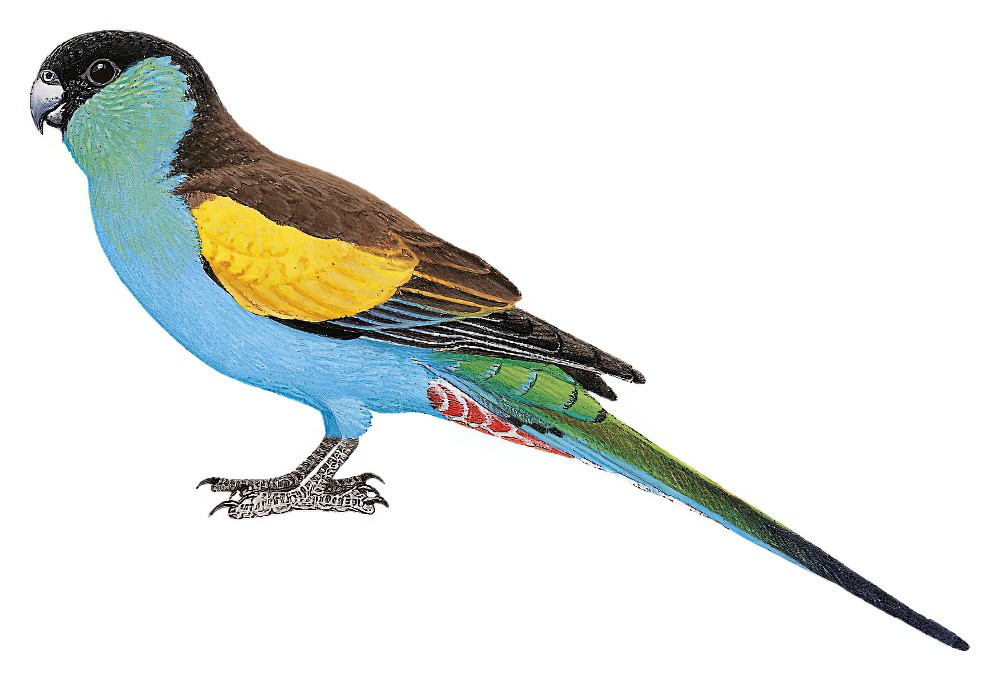Hooded Parrot / Psephotus dissimilis

Hooded Parrot
SCI Name:
Protonym: Psephotus dissimilis Proc.Zool.Soc.London Pt3 p.356
Taxonomy: Psittaciformes / Psittaculidae / Psephotus
Taxonomy Code: hoopar1
Type Locality: Mary River, Northern Territory.
Author: Collett
Publish Year: 1898
IUCN Status: Least Concern
DEFINITIONS
PSEPHOTUS
(Psittacidae; Ϯ Red-rumped Parrot P. haematonotus) Gr. ψηφωτος psēphōtos inlaid with mosaic stones or jewels < ψηφος psēphos mosaic stone; Slater et al. 1989, consider the epithet to refer to the pattern of the cheek-feathers of this small parrot, but Gould does not allude to that feature; "PSEPHOTUS HÆMATONOTUS, Gould. Red-backed Parrakeet. ... Their movements on the ground are characterized by much grace and activity, and although assembled in one great mass running over the ground like Plovers, they are generally mated in pairs,—a fact easily ascertained by the difference in the colouring of the sexes; the rich red mark on the rump of the male appearing, as the bright sun shines upon it, like a spot of fire. ... rump scarlet; tip and under surface of the shoulder, spurious wing, and the outer edge of the basal half of the primaries rich ultramarine blue; the blue of the shoulder above passing into sulphur-yellow, and forming a conspicuous spot of the latter colour in the centre of the shoulder" (Gould 1845); "Psephotus Gould, Bds. Austr., pt. 19, 1845, pl. [7]; [= 5, pl. 36 of bound volume]. Type, by monotypy, Platycercus haematonotus Gould." (Peters 1937, III, 265).
dissimilis
L. dissimilis unlike, dissimilar, different.
• "11. Pinarolestes dissimilis n. sp. Pinarolestes megarhynchus (nec Qu. u. G..), Madarász, Termész. Füz. XXII. p. 398 (1899). P. megarhyncho similis sed multo pallidior." (von Madarász 1900) (syn. Colluricincla megarhyncha tappenbecki).
• "23. Crypturus dissimilis. ?Crypturus noctivagus, Cab. (nec Wied) ... Adult male. Similar to the male of C. noctivagus, but smaller, and wanting the distinct pale superciliary stripe; upper parts more olive, especially the upper wing-coverts, rump, and upper tail-coverts ... The male of this species is very similar also to the male of C. erythropus, while the female is very much like that of C. cinnamomeus, especially in the barrings of the wings, rump, and upper tail-coverts." (Salvadori 1895) (syn. Crypturellus erythropus).
• ""Hierophasis dissimilis" Nuova forma da mutazione di "H. swinhoii GOULD" ... Ora io posseggo maschi in abito adulto, e ne ho avuto prodotti mutanti; per la qual cosa credo giunto il momento di potere considerare questi individui come una nuova razza che si va formando, illustrarne dettagliatamente i caratteri, e prospettarne la genealogia. Le attribuisco il nome di H. dissimilis." (Ghigi 1915) (syn. Lophura swinhoii).
• “5. PSEPHOTUS DISSIMILIS, sp. nov. ... Nearest to P. chrysopterygius Gould, 1857, but lacks the yellow band across the forehead; the crown is chestnut, the lower parts are verditer-blue (in the male), the under tail-coverts orange. The sexes are different in coloration. ... It possesses a singular jarring cry, and, like all Parrots, is reluctant to forsake a wounded companion.” (Collett 1898) (Psephotellus).
• ”12. T. dissimilis, nobis: T. unicolor et T. modestus, nobis, passim, as in XI, 460, &c.: Calcutta Thrush, Latham, the female. This bird, as well as the preceding one, is very closely allied to the succeeding group, Geocichla; and the mature male of the present species has the whole under-parts from the breast, except the medial line of the belly and the lower tail-coverts, which are pure white, of the same bright ferruginous colour as in G. citrinus, G. cyanotus, &c. An approach to the same colouration is exhibited by old males of T. rufulus. The female, however, shews no sign of this except on the axillaries, and on more or less of the under-surface of the wing: yet, before obtaining the male, I had perceived the affinity of this species for the Geocichlæ; and it is curious that I procured some eight or ten in the feminine plumage (whether all females, however, I cannot say, for some were only skins), before I succeeded in getting a male, which, as I all along suspected, proved to be clad in not quite so homely a garb as his mate. The male is, indeed, rather a handsome Thrush.” (Blyth 1847) (Turdus).
UPPERCASE: current genus
Uppercase first letter: generic synonym
● and ● See: generic homonyms
lowercase: species and subspecies
●: early names, variants, mispellings
‡: extinct
†: type species
Gr.: ancient Greek
L.: Latin
<: derived from
syn: synonym of
/: separates historical and modern geographic names
ex: based on
TL: type locality
OD: original diagnosis (genus) or original description (species)












